This article has been
cited by other articles in ScienceCentral.
Abstract
PURPOSE
Template-guided implant therapy has developed hand-in-hand with computed tomography (CT) to improve the accuracy of implant surgery and future prosthodontic treatment. In our present study, the accuracy and causative factors for computer-assisted implant surgery were assessed to further validate the stable clinical application of this technique.
MATERIALS AND METHODS
A total of 102 implants in 48 patients were included in this study. Implant surgery was performed with a stereolithographic template. Pre- and post-operative CTs were used to compare the planned and placed implants. Accuracy and related factors were statistically analyzed with the Spearman correlation method and the linear mixed model. Differences were considered to be statistically significant at P≤.05.
RESULTS
The mean errors of computer-assisted implant surgery were 1.09 mm at the coronal center, 1.56 mm at the apical center, and the axis deviation was 3.80°. The coronal and apical errors of the implants were found to be strongly correlated. The errors developed at the coronal center were magnified at the apical center by the fixture length. The case of anterior edentulous area and longer fixtures affected the accuracy of the implant template.
CONCLUSION
The control of errors at the coronal center and stabilization of the anterior part of the template are needed for safe implant surgery and future prosthodontic treatment.
Go to :

Keywords: Computer-assisted surgery, Dental implant, Accuracy
INTRODUCTION
Dental implant therapy has improved for the biomechanical restoration of function and the esthetic appearance of edentulous patients.
1,
2 For successful implant therapy, prosthodontic and anatomical considerations should be included at the time of treatment planning. Panorama images have been widely used for many years to aid treatment planning. However, some limitations of panorama images are evident when assessing anatomical images, such as those of the inferior alveolar nerve and maxillary sinus floor, as well as when determining the path of implant fixtures for subsequent prosthodontic treatment. Computed tomography (CT) can overcome these faults and enables a stereoscopic approach to prosthodontic treatment.
3 Three-dimensional (3D) reformatted CT images have the potential to aid the spatial analysis of anatomical objects. For implant dentistry, CT imaging began to be actively applied in the 2000s through the use of 3D image-based guidance systems. Fortin et al.
4 suggested the following classification of computer-guided surgery: passive systems by the navigation tracker; semi-active systems, whose control depends on the guide template; and active systems, which use robotic console that is operated by surgeons.
Surgical templates greatly assist implant surgery, providing prosthodontic considerations before surgery, guiding the drilling procedure and preventing unexpected surgical complications. Conventional surgical templates used to be made on a dental study model with resin, but anatomical information was not directly transmitted to surgical templates.
5 Stereolithographic templates, recently developed, have begun to be used in implant therapy. Treatment planning, established via computer software, can be transmitted to the fabricating machine that creates the stereolithographic templates.
6 These surgical templates can also provide additional information on the accurate location of anatomical structures and the bone quality under the oral mucosa, something that conventional templates cannot currently do.
However, stereolithographic template errors between the planned and the placed implants need to be minimized for the correct clinical application. The accuracy of the surgical template at surgery should be considered when performing dental implant therapy. Some studies that examine general template errors to evaluate surgical implant templates have been carried out, with several studies suggesting the causative factors that affect implant template errors to be the positioning of the template in the oral cavity, the type of guide fixation, the rotational allowance of the drill in the tube, and limited mouth opening.
7-
13 Although the accuracy of the template has been standardized through previous studies, few evaluated the correlation between the errors and the suggested causative factors.
5,
14,
15 The present template accuracy should be improved upon for a future wider use in implant therapy. Therefore, the suggested causative factors need to be evaluated and minimized.
The purpose of the present study was to evaluate the accuracy of computer-assisted template surgery for implant therapy and to study the related factors that affect accuracy so as to support the further clinical application of the technique.
Go to :

MATERIALS AND METHODS
Forty-eight patients who had received implant therapy with template-guided surgery from 2009 to 2012 in three institutes (two dental hospitals and a department of dentistry in one general hospital) were included in this study. The template supporting type (mucosa supported or tooth supported), maxillary or mandibular arch, anterior-posterior (AP) location (anterior, premolar, molar), the length of the implants, and the institute where the procedure was performed were considered as error-related causative factors (
Table 1).
Table 1
Patients and causative factors


A total of 102 fixtures were implanted. These were the Osstem US II (Osstem Implant, Seoul, Korea), Superline (Dentium, Seoul, Korea), and Branemark MKIII Groovy (Nobel Biocare, Kloten, Switzerland). Fixtures were selected according to prosthodontic options and patient choice. Preoperative 3D CT was taken for the fabrication of the stereolithographic template with the computer software (OnDemand3D; Cybermed Co., Seoul, Korea). A postoperative 3D CT was taken within 2 months after the computer-assisted implant surgery for comparison. Patients who had surgical complications, such as infection or early implant failure, were excluded from the study. The study protocol was reviewed by the Institutional Review Boards of the participating institutes. All patients were given the protocol information and informed consent was obtained.
The dental study models were made after taking the arch impressions of the patient. According to the prosthodontic plan, diagnostic wax-up was performed and the preliminary position of the implant fixture was determined. The dental study models were scanned and matched with the preoperative CT images for simulation surgery by the computer software (OnDemand3D) and the drill sequence, size of fixture, and the location were determined according to the prospective prosthodontic consideration (
Fig. 1).
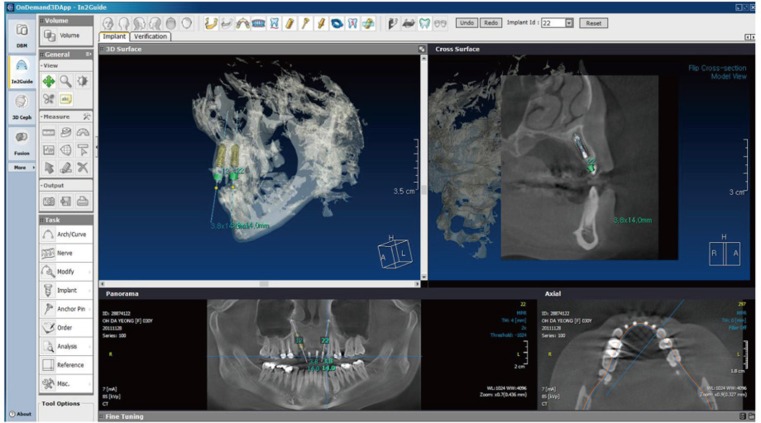 | Fig. 1The location and angulation of the implant were determined through the use of planning software and virtual surgery by considering the critical anatomical structures and the future dental prostheses. 
|
Three-dimensional stereolithographic models were printed out through surface registration and model scanning. Information from the simulation surgery permitted the creation of the stereolithographic template for the guided implant surgery with a three dimensional printer (Connex350®3D printing system; Object Geometries Inc., Billerica, MA, USA). Metal sleeves for drill guidance were attached to the template (
Fig. 2).
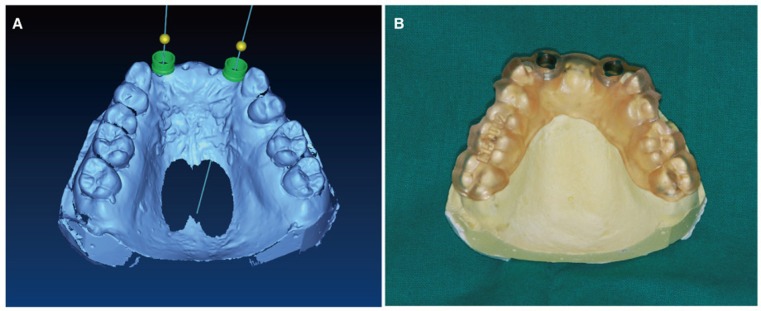 | Fig. 2The information from the planned fixture was used to create the stereolithographic implant template. (A) Completion of planning of implant surgery on 3D software, (B) Stereolithographic template for computer-assisted implant surgery. 
|
Routine preparation of the surgical field and administration of local anesthesia were performed. A crestal incision was made on the edentulous alveolar ridge and the mucoperiosteal flap was elevated. The surgical template was adapted in the patient's oral cavity for the planned sequential drilling. Fixtures were inserted through metal sleeves, after being locked at connecting implant mounters (
Fig. 3). Cover screws were engaged and suturing was performed without tension. The tooth-supported (partially edentulous) type of template acquired retention from the residual teeth. The mucosa-supported (completely edentulous) type was supported by anchoring pins and the covering mucosa. Antibiotics and analgesics were prescribed after surgery. Patients were periodically checked for wound care, followed by prosthodontic treatment.
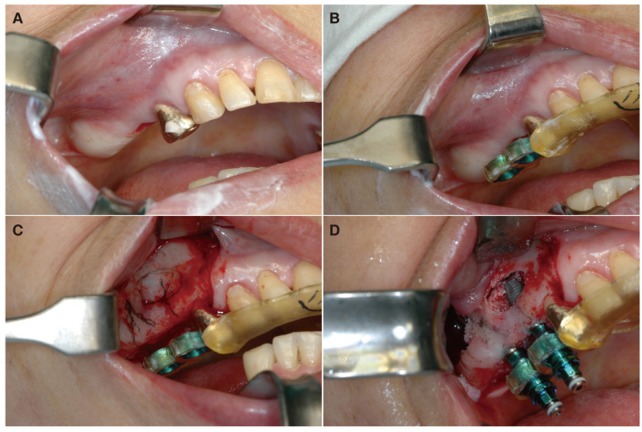 | Fig. 3Surgical procedure for template-guided implant surgery. (A) Preparation of operation field, (B) Setting of surgical template in the oral cavity, (C) Flap elevation for sequential drilling, (D) Implantation of fixture guided by the template. 
|
Pre- and postoperative CT images were loaded and the two serial images were fused through the use of a maximum mutual information (MMI) algorithm on the computer program (OnDemand3D).
16 The planned and placed implants from the same patients were superimposed and the errors were calculated. The coronal distances, apical distances, and axis deviations between the two implants were compared, and the linear distances (total errors) of the coronal and apical centers were disassembled into horizontal and vertical deviations (
Fig. 4).
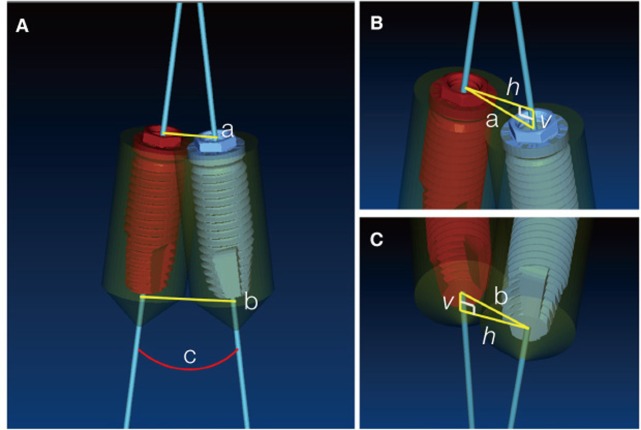 | Fig. 4
(A) Comparison of the planned and placed implants by superimposition of the pre- and postoperative images, (B) Disassembly of the total errors into horizontal and vertical directions at the coronal center, (C) Disassembly of the total errors into horizontal and vertical directions at the apical center.
a: coronal distance, b: apical distance, c: axis deviation, h: horizontal deviation, v: vertical deviation.

|
The mean values of each measure were calculated and correlations were assessed with each causative factor: template supporting type, maxillary or mandibular arch, AP location (anterior, premolar, molar), length of implants, and the institutes involved.
The mean errors of the coronal and apical distances and the axis deviations were calculated and their correlations were analyzed with the Spearman correlation method. Correlations of errors with causative factors were analyzed with the linear mixed model and each factor variable was compared. The statistical analyses were performed with SPSS (version 20.0 for Windows; SPSS, Chicago, IL, USA). Differences were considered to be statistically significant at P≤.05.
Go to :

RESULTS
The mean errors between the planned and placed implants were 1.09 ± 1.10 mm at the coronal center, 1.56 ± 1.48 mm at the apical center, and 3.80 ± 3.24° in the axis. The horizontal deviation was 0.72 ± 0.75 mm at the coronal center and 1.23 ± 1.25 mm at the apical center. The vertical deviation was 0.66 ± 0.95 mm at the coronal center and 0.69 ± 1.03 mm at the apical center (
Table 2). The total errors at the coronal and apical centers were strongly correlated with their horizontal deviations (
r = 0.83 and
r = 0.89, respectively). Vertical deviations were also strongly correlated between the coronal and apical centers (
r = 0.92) (
Table 3).
Table 2
Mean errors between the planned and placed implants (Mean ± SD)


Table 3
Correlations between errors
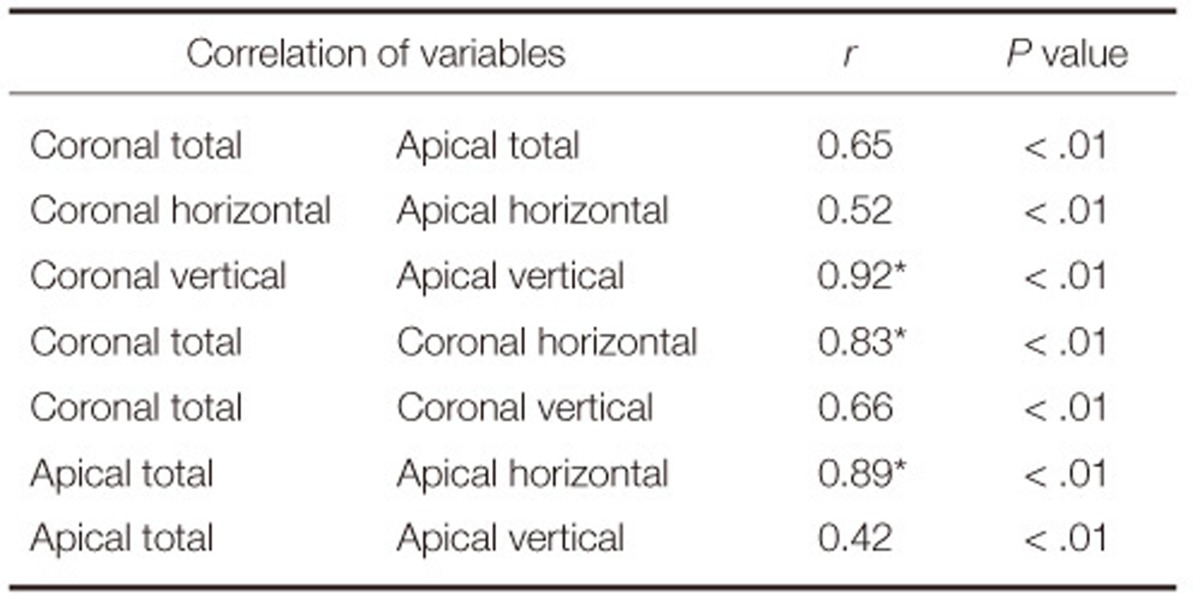

The difference in the template supporting type was significant for the total error at the apical center of the implants. Only the horizontal deviation of the implant apex of the mandibular arch was less than that of the maxillary arch. Significant errors were found according to the AP location of the implants. These errors were larger in the anterior area than in the premolar and molar areas in the coronal total and vertical, and the apical vertical dimensions. The errors were all increased in proportion to the length of the implants, except in the coronal total and horizontal dimension. The institutes where the procedures were performed did not affect the accuracy of the template (
Table 4).
Table 4
Significance (P value) of each error that correlated with causative factors for implant fixtures
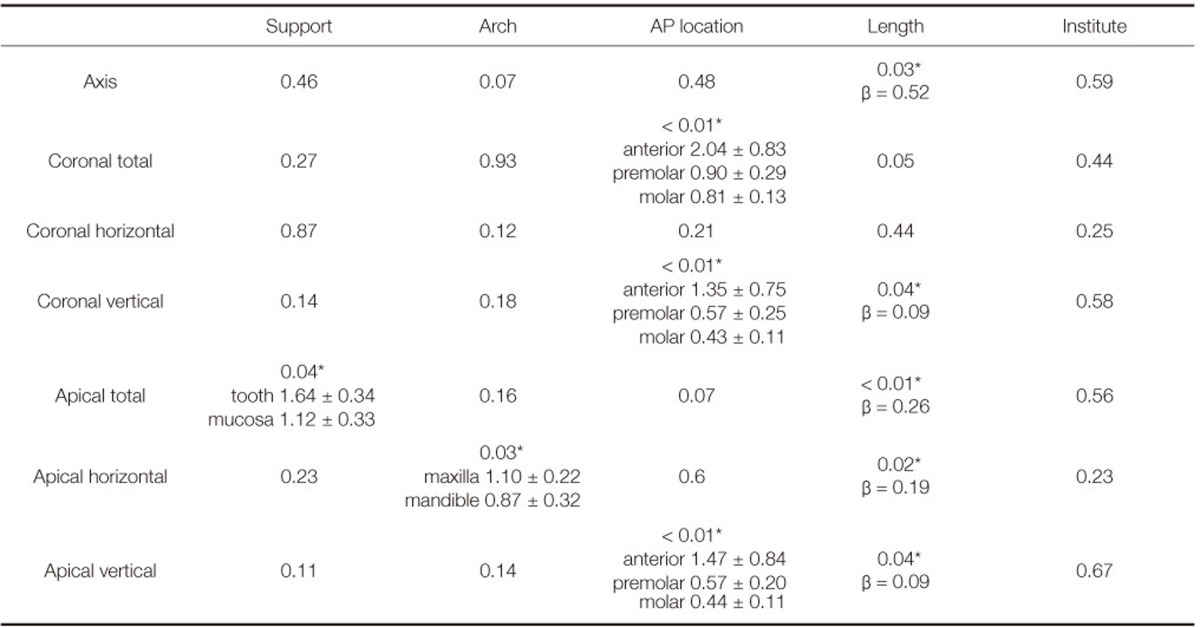

Go to :

DISCUSSION
CT imaging is a very helpful tool for implant surgery in the case of an unfavorable alveolar bone condition.
5 Conventional surgical templates used to be made with resin on dental study models to guide the planned positions of implant fixtures during the surgical procedure. Due to the development of the stereolithographic modeling technique, surgical templates can be designed with accuracy and reproducibility through 3D imaging of a patient's maxilla and mandible. The templates also contain information about the planned location and direction of implant fixtures when planning the prosthodontic treatment. Clinicians can therefore establish and carry out a safer treatment plan in the actual treatment of the patients.
17
Template-guided implant surgery can improve accuracy and reduce the need for additional bone grafts in atrophied alveolar ridge. However, errors between the planned and placed implant appeared in all systems of template-guided implant surgery, which caused various deviations.
8,
13,
18 Studies that evaluated template-guided implants have been performed for decades but few studies have dealt with the errors of template-guided implant surgery in terms of causative factors that should be resolved for future widespread clinical use of the technique.
19
Sarment et al.
20 and Kramer et al.
21 found that computer-guided surgical templates were more accurate than conventional surgical templates, but these studies were performed
in vitro, with the
in vivo studies showing poorer accuracy.
14,
15 Cassetta et al.
8 suggested that the potential mechanical (intrinsic) error is a more significant factor than the other variables that could affect the accuracy of template guided systems. The intrinsic errors affecting the accuracy were caused by the diameter and length of the guide sleeve of the template and the distance between the undersurface of the template and the targeted alveolar crest.
22 The potential intrinsic error developing from the sleeve unit was pointed out by Vrielinck et al.
15 to be caused by the fact that the diameter of the sleeve was slightly larger than that of the drill. However, mechanical errors were found to be relatively smaller than the errors that occurred in the clinical procedure,
14,
15 and can be controllable in the fabrication phase.
Most studies that have investigated template-guided implant surgery showed similar levels of accuracy. Schneider et al.
23 conducted a meta-regression analysis of the systematic review of studies in the accuracy of various surgical templates. In that study, the mean error was 1.07 mm at the coronal center and 1.63 mm at the apical center and the axis deviation was 5.26°. In another systematic review performed by Van Assche et al.,
24 the mean error was 0.99 mm at the coronal center, 1.24 mm at the apical center, and the axis deviation was 3.81°. In our present study, the errors at the coronal and apical centers and direction were also analyzed; the mean values were 1.09 mm at the coronal center, 1.56 mm at the apical center, and 3.80° in the axis deviation. Thus, our present data are similar to those of the previously presented systematic reviews. However, some outliers appeared due to severe errors between the planned and placed fixtures. These errors were enough to cause complications in the case of complex anatomical structures, such as the maxillary sinus and inferior alveolar nerve. Such cases should be considered by clinicians so that they use CT to become well informed about critical anatomical structures rather than depend on computer-guided surgical templates alone. Further effort should be exerted to decrease the deviation of errors among the cases as well as the errors between the planned and the placed fixtures.
Strong correlations were shown between the coronal vertical and apical vertical, coronal total and coronal horizontal, and apical total and apical horizontal dimensions (
Table 3). The vertical errors changed simultaneously in both the coronal and apical centers. The implant deviation between the planned and placed implants was more affected by horizontal deviations than by vertical deviations. Errors in horizontal deviation can limit prospective prosthodontic placement, whereas errors in vertical depth can cause damage to anatomical structures such as the inferior alveolar nerve and floor of the maxillary sinus. The control of errors in the surgical procedure should be focused on securing the prospective placement of dental prostheses by decreasing horizontal deviation as well as protecting anatomical structures. The errors increased in proportion to the length of the implant fixtures except in the coronal total and horizontal dimensions, which implies that errors developed at the coronal center would be magnified at the apical center by the fixture length.
9 The fundamenal errors occurred in the coronal portion and all efforts to decrease errors during surgery should be exerted in the coronal point.
Ozan et al.
5 compared the accuracy of three different types of computer-guided implant templates, which were the tooth-supported, bone-supported, and mucosa-supported types, and suggested that the tooth-supported type were more accurate. In the present study, although mucosa-supported templates had less error than the tooth-supported type (1.12 mm vs. 1.64 mm, respectively) in the apical total dimension, significant differences were not found in the other dimensions. When comparing the arch of the maxilla and mandible, a difference was only found in the horizontal deviation of the apical center (maxilla = 1.10 mm, mandible = 0.87 mm). The template supporting type and a maxillary or mandibular arch did not largely affect the accuracy-at least in this study-but a relative magnification of the horizontal deviation was found at the apical center. It may be therefore conceded that the template-guided implant surgery can be performed stably regardless of supporting type and arch but, the control of errors at the coronal level is needed to decrease the error at the apical center for the protection of anatomical structures in the surgical procedure.
With respect to the anterior-posterior locations of implants, the coronal total, coronal vertical, and apical vertical dimensions showed significant differences, and the anterior area (incisor and canine) was more deviated than the premolar and molar areas. The importance of accurate positioning of implant fixtures in anterior teeth cannot be too highly emphasized for esthetic considerations. Vertical errors in the anterior area are thought to be due, in particular, to the metal sleeve housing parts, which, in the case of anterior edentulous ridge, should be stabilized to control the vertical movement.
Template-guided implant surgery was intended to improve both the accuracy of prospective prosthodontic treatment and the safety of implant surgery. In our present study, accuracy did not differ between the different institutes. Template-guided implant surgery was thus thought to be performed with stable errors, regardless of different environments and surgeons.
The causative factors related to accuracy of surgical template during surgery were suggested by several studies. In the present study, the related factor; template supporting type, maxillary or mandibular arch, anterior-posterior location, length of implants and clinicians (different institutes) were considered for clinical implication. Template-guided surgery system was stable related to suggested causative factors in this study. But, in the case of anterior edentulous ridge and drilling control at the coronal part, special precaution was needed for clinicians.
This retrospective study had some limitations, such as too few and unevenly distributed cases to evaluate the causative factors. For a more reliable evaluation of template-guided surgery, further studies, based on a more suitable prospective study design, are needed.
Go to :

CONCLUSION
The stereolithographic template-guided implant surgery in the present study had errors of 1.09 mm at the coronal center, 1.56 mm at the apical center, and 3.80° in axis deviation. Controlling the accuracy in horizontal deviation at the coronal center and ensuring template stabilization in the case of anterior edentulous areas should be considered for safe implant surgery and prospective prosthodontic treatment.
Go to :

ACKNOWLEDGEMENTS
The authors would like to thank Min-Ju Kim, Biostatistician in Asan Biomedical Research Center, for her support in statistical data analysis.
Go to :

Notes
Go to :

References
1. Besimo C, Lambrecht JT, Nidecker A. Dental implant treatment planning with reformatted computed tomography. Dentomaxillofac Radiol. 1995; 24:264–267. PMID:
9161173.

2. Fortin T, Coudert JL, Champleboux G, Sautot P, Lavallée S. Computer-assisted dental implant surgery using computed tomography. J Image Guid Surg. 1995; 1:53–58. PMID:
9079427.

3. Jacobs R, Adriansens A, Naert I, Quirynen M, Hermans R, Van Steenberghe D. Predictability of reformatted computed tomography for pre-operative planning of endosseous implants. Dentomaxillofac Radiol. 1999; 28:37–41. PMID:
10202477.

4. Fortin T, Champleboux G, Bianchi S, Buatois H, Coudert JL. Precision of transfer of preoperative planning for oral implants based on cone-beam CT-scan images through a robotic drilling machine. Clin Oral Implants Res. 2002; 13:651–656. PMID:
12519341.

5. Ozan O, Turkyilmaz I, Ersoy AE, McGlumphy EA, Rosenstiel SF. Clinical accuracy of 3 different types of computed tomography-derived stereolithographic surgical guides in implant placement. J Oral Maxillofac Surg. 2009; 67:394–401. PMID:
19138616.

6. Jacobs R, Adriansens A, Verstreken K, Suetens P, van Steenberghe D. Predictability of a three-dimensional planning system for oral implant surgery. Dentomaxillofac Radiol. 1999; 28:105–111. PMID:
10522199.

7. Arisan V, Karabuda ZC, Ozdemir T. Accuracy of two stereolithographic guide systems for computer-aided implant placement: a computed tomography-based clinical comparative study. J Periodontol. 2010; 81:43–51. PMID:
20059416.
8. Cassetta M, Di Mambro A, Giansanti M, Stefanelli LV, Cavallini C. The intrinsic error of a stereolithographic surgical template in implant guided surgery. Int J Oral Maxillofac Surg. 2013; 42:264–275. PMID:
22789635.

9. D'haese J, Van De Velde T, Elaut L, De Bruyn H. A prospective study on the accuracy of mucosally supported stereolithographic surgical guides in fully edentulous maxillae. Clin Implant Dent Relat Res. 2012; 14:293–303. PMID:
19906267.
10. Park C, Raigrodski AJ, Rosen J, Spiekerman C, London RM. Accuracy of implant placement using precision surgical guides with varying occlusogingival heights: an in vitro study. J Prosthet Dent. 2009; 101:372–381. PMID:
19463664.

11. Stumpel LJ. Deformation of stereolithographically produced surgical guides: an observational case series report. Clin Implant Dent Relat Res. 2012; 14:442–453. PMID:
20156227.

12. Valente F, Schiroli G, Sbrenna A. Accuracy of computer-aided oral implant surgery: a clinical and radiographic study. Int J Oral Maxillofac Implants. 2009; 24:234–242. PMID:
19492638.
13. Vercruyssen M, Jacobs R, Van Assche N, van Steenberghe D. The use of CT scan based planning for oral rehabilitation by means of implants and its transfer to the surgical field: a critical review on accuracy. J Oral Rehabil. 2008; 35:454–474. PMID:
18429973.

14. Di Giacomo GA, Cury PR, de Araujo NS, Sendyk WR, Sendyk CL. Clinical application of stereolithographic surgical guides for implant placement: preliminary results. J Periodontol. 2005; 76:503–507. PMID:
15857088.
15. Vrielinck L, Politis C, Schepers S, Pauwels M, Naert I. Image-based planning and clinical validation of zygoma and pterygoid implant placement in patients with severe bone atrophy using customized drill guides. Preliminary results from a prospective clinical follow-up study. Int J Oral Maxillofac Surg. 2003; 32:7–14. PMID:
12653226.

16. Lee JH, Kim MJ, Kim SM, Kwon OH, Kim YK. The 3D CT superimposition method using image fusion based on the maximum mutual information algorithm for the assessment of oral and maxillofacial surgery treatment results. Oral Surg Oral Med Oral Pathol Oral Radiol. 2012; 114:167–174. PMID:
22776729.

17. Verstreken K, Van Cleynenbreugel J, Marchal G, Naert I, Suetens P, van Steenberghe D. Computer-assisted planning of oral implant surgery: a three-dimensional approach. Int J Oral Maxillofac Implants. 1996; 11:806–810. PMID:
8990645.
18. Fortin T, Camby E, Alik M, Isidori M, Bouchet H. Panoramic images versus three-dimensional planning software for oral implant planning in atrophied posterior maxillary: a clinical radiological study. Clin Implant Dent Relat Res. 2013; 15:198–204. PMID:
21477064.

19. Cassetta M, Stefanelli LV, Giansanti M, Calasso S. Accuracy of implant placement with a stereolithographic surgical template. Int J Oral Maxillofac Implants. 2012; 27:655–663. PMID:
22616060.
20. Sarment DP, Sukovic P, Clinthorne N. Accuracy of implant placement with a stereolithographic surgical guide. Int J Oral Maxillofac Implants. 2003; 18:571–577. PMID:
12939011.
21. Kramer FJ, Baethge C, Swennen G, Rosahl S. Navigated vs. conventional implant insertion for maxillary single tooth replacement. Clin Oral Implants Res. 2005; 16:60–68. PMID:
15642032.

22. Choi M, Romberg E, Driscoll CF. Effects of varied dimensions of surgical guides on implant angulations. J Prosthet Dent. 2004; 92:463–469. PMID:
15523335.

23. Schneider D, Marquardt P, Zwahlen M, Jung RE. A systematic review on the accuracy and the clinical outcome of computer-guided template-based implant dentistry. Clin Oral Implants Res. 2009; 20:73–86. PMID:
19663953.

24. Van Assche N, Vercruyssen M, Coucke W, Teughels W, Jacobs R, Quirynen M. Accuracy of computer-aided implant placement. Clin Oral Implants Res. 2012; 23:112–123. PMID:
23062136.

Go to :







 PDF
PDF ePub
ePub Citation
Citation Print
Print








 XML Download
XML Download